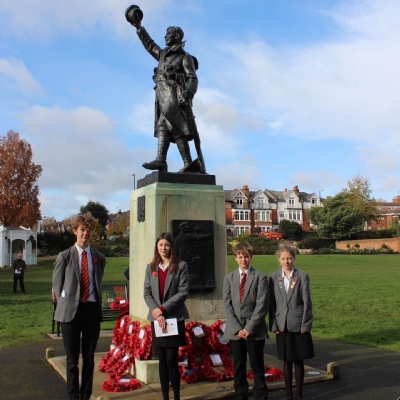Remembering

On Monday this week, we held two Acts of Remembrance, one in school and one in Radnor Gardens with the staff and pupils from St Catherine’s School. In my closing remarks, I shared my thoughts about what I try to remember each year during the two minutes’ silence, because it is not easy to know what to think about when you have no personal experience of war.
The historian, Sir Martin Gilbert, wrote this as the last sentence in his book The First World War: ‘All wars end up being reduced to statistics, strategies, debates about their origins and results. These debates about war are important, but not more important than the human story of those who fought in them.’
There is a village in northern France called Mametz. Nearby is a place called Mansel Copse, a cemetery that, with so many others, commemorates the worst day in the history of the British Army on 1st July 1916 when 20,000 men lost their lives and another 40,000 were wounded on the first day of the Battle of the Somme.
One of the graves in that cemetery belongs to a man called William Noel Hodgson, a lieutenant in the 9th Devonshire Regiment, who was 23 when he died. He had been at Christ Church, Oxford. He was a scholar, a sportsman, a gentleman. His biography is called ‘The Gentle Poet’, for he was also a creative man, a man with much to live for. He joined the war, like many others at the time, out of a sense of patriotism, pride and a desire to serve his country. His nickname among the men he led was ‘smiler’.
He was the Bombing Officer for his battalion so it was his job to make sure that his men had the ammunition they needed. While he was bringing up weapons to the front line trench that morning he was hit in the throat by a bullet and was killed instantly.
There are twists to the story of what happened that day at Mansel Copse. One of the officers in the Devonshire Regiment, Captain Duncan Martin, was a talented model maker. A few weeks before the Battle of the Somme began he was back in England on leave. Using clay, he made a model of the battlefield, as he saw it, from Mansel Copse. He showed this model to his superior officers but they reassured him that any German positions would be knocked out by the artillery bombardment that lasted for a week before the attack was due to begin. They were wrong.
The ground from Mansel Copse slopes down into a valley and then up the other side to Mametz itself. You can just about see the town today, although there are, of course, a lot more trees there now than in 1916. There was a churchyard which contained a large crucifix and it was here that the Germans had set up a machine gun. Captain Martin knew that if this machine gun was not destroyed then it would cause havoc among his men. He was right and he too lost his life that day. Like so many other places on the Somme that day, the defences were not destroyed.
In the end I don’t know enough about William Noel Hodgson and maybe I never will. I know where he went to school and I have some idea about what other people thought of him, and I know where he died. But perhaps it is better that way – to remember heroism and an almost romantic notion of war rather than to think too carefully about the reality of being killed instantly by a bullet in the throat.
Either way, I know that Hodgson wrote a poem called ‘Before Action’. I read it long before I knew anything about him. It is poignant because it predicts death, and Hodgson finished it just two days before he was killed. In the first two verses he asks God to make him a soldier and to make him a man.
The final verse goes like this:
I, that on my familiar hill
Saw with uncomprehending eyes
A hundred of Thy sunsets spill
Their fresh and sanguine sacrifice.
Ere the sun swings his noonday sword
Must say goodbye to all of this.
By all delights that I shall miss,
Help me to die, O Lord.
As you leave the cemetery at Mansel Copse, you see a simple inscription carved in stone at the gateway. It says, ‘The Devonshires held this trench. The Devonshires hold it still.’
That is how I spent my time on Monday morning. I thought about William Noel Hodgson and I thought about his poem. It may not be much, but it helped me to remember.